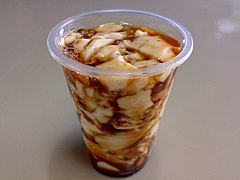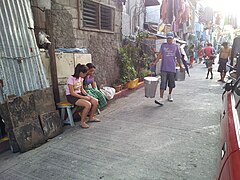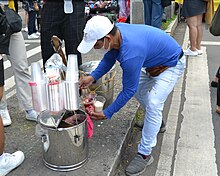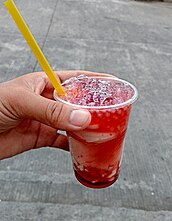Taho
 A cup oftahô | |
| Course | Dessert,snack |
|---|---|
| Place of origin | Philippines |
| Serving temperature | Warm or room temperature |
| Main ingredients | Silkentofu,arnibal(brown sugarsyrup),sagopearls |
| 323[1]kcal | |
| Similar dishes | Douhua |

Tahô(Tagalog:[tɐˈhoʔ]) is a Philippinesnack foodmade of freshsoft/silkentofu,arnibal(sweetener and flavoring), andsago pearl(similar totapioca pearls).[2]This staplecomfort foodis a signature sweet and tahôpeddlerscan be found all over the country.
History
The dish originates fromHokkientāu-hū( đậu hủ ), which was introduced to the Philippines viaHokkienimmigrants.[3]
Processing and preparation
Mosttahôvendors prepare the separate ingredients before dawn. The main ingredient, fresh soft/silken tofu, is processed to a consistency that is very similar to a very finecustard.Thebrown sugariscaramelizedand mixed with water to create a viscousamber-colored syrup calledarnibal.Flavors likevanillaare sometimes added to thearnibal.Sagopearls, which can be bought at the local market, are boiled to a gummy consistency until they are a translucent white. In lieu of making soft tofu from scratch, one can use a soft tofu mix from the store.[4]
Leftovertahô,if significant amounts are found, is sometimes repurposed intotokwa( "tofu" in Filipino).
Marketing


TheMágtatahô(tahôvendor) is a common sight in the Philippine streets. Amágtatahôcarries two largealuminumbuckets that hang from each end of acarrying pole.The larger bucket carries the tofu base; the smaller bucket holds thearnibal,sago pearls, and cash box.
Tahôvendorspeddletheir product in a distinctive manner, walking at a leisurely pace on the sidewalk or shoulder of the road. Mostmágtatahôtravel a habitual route and schedule, often calling out"Tahô!"in a loud and full rising inflection to attract customers’ attention. Although vendors are most likely to ply their routes early in the morning, it is not uncommon for amágtatahôto work in the late afternoon or evening as well.
Mostmágtatahôcarry plastic cups, often in two sizes, and spoons or straws to serve their product. Some customers in residential areas tend to use their own cups, and the vendors price their product accordingly (usually at around twentyPhilippine pesos,orUS$0.42 for a standard-sized mug). Using a wide, shallow metalwatch glass-shapedscoop,they skim the surface of the bean curd and toss out any excess water, before scooping the bean curd itself into a cup. Then, using a long, thin metal ladle with a tiny bowl, they scoopsagoortapiocapearls andarnibalinto the cup, loosely mixing it in.
Eating
Tahôis enjoyed either with a spoon, sipping it with a straw, or by simply slurping it straight from the cup. Though traditionally served warm, cold varieties exist in supermarkets and food stalls incafeteriaswith bean curd in a solid, unbroken state. These pre-packed cups, sold with a plastic spoon or woodenice popstick, tend to contain firmer tofu.
Varieties

InBaguio,there is also astrawberryvariety oftahô,wherein strawberry syrup is used instead ofarnibal.Other varieties use whitecane sugarsyrup, orchocolatesauce.[citation needed] [5]
See also
References
- ^"Taho: Nutrition Facts".RetrievedJuly 16,2008.
- ^"How to make Taho".Archived fromthe originalon May 3, 2007.RetrievedMay 5,2007.
- ^Yap, Gloria Chan (1977)."Hokkien Chinese Borrowings in Tagalog"(PDF).Pacific Linguistics.8(71).
- ^"Homemade Taho Recipe".
- ^"Baguio Food Trip: Strawberry Taho".January 26, 2013.RetrievedDecember 21,2017.

